Table of contents
- 25 years of MOTORRAD Classic A quarter of a century MOTORRAD Classic
- The Italian diva
- The Indians attack
- Beware!
- Two-wheeled Rolls Royce
- Star ride
- Put pressure on the boxer
- Slim figure
- Sixes in store
- Always full throttle
- Friedel his machine
- Restoring takes time.
- Reach for the stars
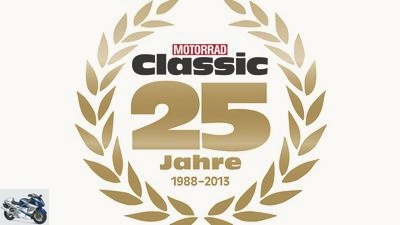
archive
Sports & scene
The best stories from 25 years of MOTORRAD Classic
25 years of MOTORRAD Classic
A quarter of a century MOTORRAD Classic
Content of
MOTORRAD Classic has been providing its readers with material for a quarter of a century. Time to look back on the most intoxicating stories.
Gerhard Eirich
02/21/2013
Compared to the many decades of two-wheeler history, the two and a half decades of MOTORRAD Classic’s existence may seem modest. But looking back and leafing through the 152 issues, it is impressive how many memorable stories the numerous authors have written over the years about imposing, beautiful, bizarre or simply extremely rare motorcycles. You should actually show a lot more, and yet twelve selected stories should simply be rummaged out here that the editors consider to be worth showing. Looking back is not only fun, it is also stimulating. Quite a few times it flashes through the rummaging: You have to, or again, or should make this or that completely different story. In this respect, it is to a certain extent also a look ahead. To the stories to come for the next 25 years.
The Italian diva
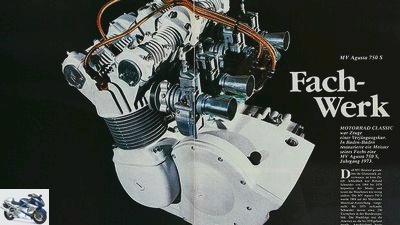
mps photo studio
The second edition ever, issue 1/1988.
In issue 1/1988, the second issue of MOTORRAD Classic, a motorcycle was the title topic, which many classic enthusiasts see as one of the most beautiful and fascinating bikes ever: the MV Agusta 750 S. The occasion: the restoration of a copy by Roland Schneider, who was an importer of the brand from 1969 to 1978. Schneider sold around 250 copies of the 750 S in Germany until 1975. The bike from 1973 with just 13,017 kilometers on the clock presented itself at the beginning of the work in an unusually neglected condition for the mileage, its value is estimated at a comparatively meager 16,000 marks. The MV, meticulously rebuilt with numerous new parts, is in the end in a practically better condition than new and represents a value of 29,000 marks.
Both amounts that have now multiplied and that MV enthusiasts can only dream of today.
The Indians attack

mps photo studio
Issue 5/1990. In focus: The Indian Chief.
Indian riders know why they didn’t buy a Harley: The V-Twins from Springfield have always been very different. For example, the author’s introduction to the story in issue 5/1990, in which the driving experience with a Indian Chief, built in 1937. The arrangement of the controls already requires full concentration at first – the throttle grip on the left, the twist grip on the right regulates the ignition point, the rocker switch on the right for the clutch, the gear stick is on the right front of the tank. The elaborate start procedure must be followed exactly if the mighty V2 is to jump on the first step. Once in motion, the 220-kilogram Indian proves to be amazingly handy on the streets in and around Berlin, and the engine is extremely powerful. Only the saddle and running boards that are positioned far to the front are a nuisance in connection with the wide, sweeping handlebars. But: “In 1953 the factory gates in Springfield closed forever.” This Chief, however, has survived to this day.
Beware!
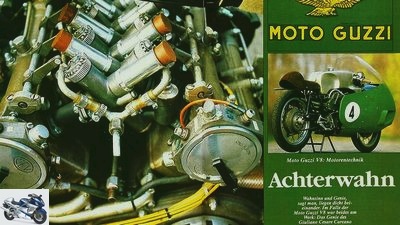
mps photo studio
Issue 1/1988. In focus: technology and racing history of the Moto Guzi V8.
Madness and genius are close together, the author philosophizes in the opening credits of the article about the Moto Guzzi V8.
In issue 1/1988, MOTORRAD Classic explains the technology and racing history of the V8, which fought for success in the 1956 and 1957 Grand Prix. Why a V8? The four-cylinder bikes from Gilera and MV Agusta drove the single-cylinder engines of the competition in the face, a new engine was needed – a V8 was awarded the contract. The engine housing made of expensive but light magnesium integrated the swing arm bearing, which in turn saved weight in the frame construction. It should be narrow and gain advantages thanks to the possible speeds of up to 12500 rpm. The short-stroke, water-cooled V8 generated 78 hp from just under 500 cm³, which enabled the machine, which weighed 147 kilograms when dry, to set a world record over ten kilometers in 1957: average speed 243.11 km / h. But it caused problems when it came to racing: when she made her debut in Imola in 1956, she was out of action due to overheating. The rest of the season it never reached the finish line, the ignition and the eight carburettors were too difficult to adjust, and the crankshaft bearings did not hold up. Better results followed in 1957, but it was never enough to win a GP. At the end of the season, Moto Guzzi retired from racing. Pity.
Two-wheeled Rolls Royce
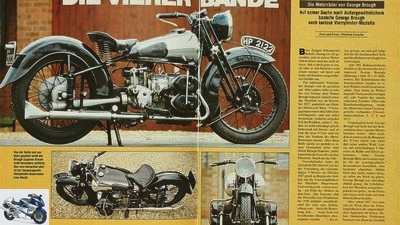
mps photo studio
Issue 1/1991. In focus: George Brough’s motorcycles.
The Brough Superior models achieved a high level of popularity primarily through the world records that were set in the 1920s and 1930s. In fact, George Brough mostly used the legendary, super-powerful JAP-V2 engines. But the busy speed freak also tinkered with strange four-cylinder models, which were to be presented in issue 1/1991 and to be examined more closely. In November 1927, for example, a model with a self-designed V4 engine was presented, which, however, did not go into series production and – as Brough later admitted – was actually impassable. Just one year later, another four-cylinder bike rolled out, this time with a side-controlled row four with 900 cc. But cooling problems in the rear cylinders and the death of the designer Marchant led to the project being abandoned. Further attempts with the installation of Austin engines in the Austin Four with twin rear tires were limited to ten or eleven copies between 1932 and 1934. The production of the spectacular, almost identical models Dream (see pictures) and Golden Dream (paint in gold) with the four-cylinder boxer engine, whose four pistons move in one direction and therefore had to be counterbalanced with counterweights, were discontinued because the war began in 1939. A total of five Golden Dreams had only been built by then.
Star ride
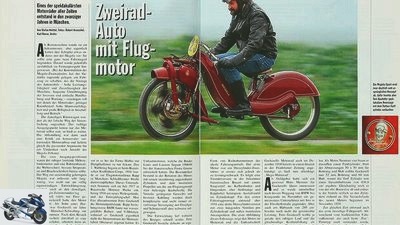
mps photo studio
Issue 5/1996. In focus: the Megola.
MOTORRAD Classic presented an equally unusual and unfortunately unsuccessful concept in issue 5/1996 – the Megola. It was created in Munich in the early 1920s. The mechanic Fritz Gockerell, fascinated by the aircraft radial engines, developed a five-cylinder radial engine with side-mounted valves and almost 637 cm³ from 1919. A vehicle should be created that combines the advantages of the two-wheeler with those of the car. The smooth-running wheel hub motor and the light sheet steel shell frame, which should offer a comfortable seating position and weather protection, followed the line of thought. In the absence of a clutch, however, the engine had to be stalled to stop, which made a sliding start necessary every time to drive off. The engine was initially installed on the rear wheel, but moved to the front wheel in 1921. In 1922 the Megola went into production as a “two-wheeled car”, then in 1923 with sports handlebars and now 110 instead of 95 km / h top speed. Because the clutch and transmission were missing, and the driving behavior with large, unsprung masses at the front and a light rear, it took some getting used to, the concept could not prevail. The project was too uncertain for the sponsors of the parent company in Switzerland, the debts increased, and in 1925 the Megola company was liquidated.
Put pressure on the boxer
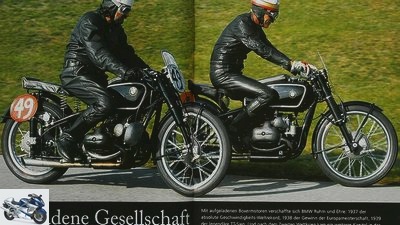
mps photo studio
Issue 1/2004. In focus: BMW compressor.
It was the dominance of British racing competition that ultimately led to the development of the BMW Kompressor. More power was needed. Rudolf Schleicher and Sepp Hopf had been thinking about supercharging for a long time. But initially this idea was blocked for a long time. The aforementioned shame and Ernst Henne’s idea of setting a prestigious speed record, however, allowed the project to flourish. As is well known, Henne set the new record he was aiming for in 1929 with 216.75 km / h, followed by his first victory at the German Grand Prix in the half-liter class in 1933 – the beginning of a racing history of the supercharged BMW that lasted until 1950. But not only the BMW was loaded, but also the author Knittel – for trial laps on the BMW test site. It is easy to push, he writes in issue 1/2004, the deep, loud exhaust noise is impressive, but it is also easy to drive. From 5000 rpm the boxer increases its power significantly, upshifting goes without any problems, downshifting with double-declutching and a little practice too. In the end, he understands why the supercharged BMW always put a smile on the driver’s face.
Slim figure
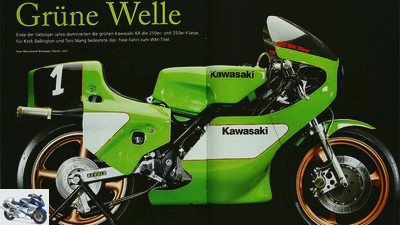
mps photo studio
Issue 1/2005. In focus: Kawasaki KR 250/350.
Distinguished visitors: Not every day you have a world champion machine as a studio guest. MOTORRAD Classic received this honor for issue 1/2005. In the late seventies and early eighties they collected Kawasaki KR 250/350 racers take a series of world titles. Drivers like Kork Ballington, Gregg Hansford and of course Toni Mang knew how to use the potential of the green racers. Mang and the legendary Sepp Schlogl in particular continued to develop the high-quality technology consistently, leaving the competition with little chance. A look at the technology of the KR model, which recently weighed barely more than 90 kilograms, allows the author to see in awe how early the Kawa already had details that only became common much later: shock absorber with expansion tank, PVM cast wheels or screwed-on silencers, to name but a few to name a few. The design of the engine (cylinders arranged one behind the other with a slight offset, carburettor flanged on the side) made a very narrow cladding possible, which led to an extremely small frontal area and therefore very little air resistance. Not a blue, but a green miracle.
Sixes in store
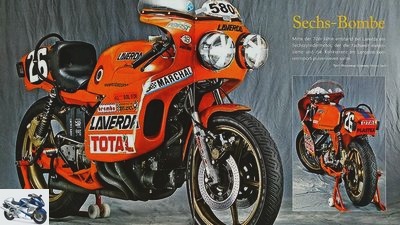
mps photo studio
Issue 5/2005. In focus: Laverda six-cylinder.
Anyone who has seen them in action and, above all, heard them once, will never forget them again: the Laverda six-cylinder. According to Piero Laverda, the only functional copy – the ex-company boss usually moves it personally to classic racing events – is for the article in issue 5/2005 in the studio. The orange legend is a phenomenon, a bike that offers breathtaking views from every angle. With a monumental engine, developed by Giulio Alfieri, once in service with Maserati, which conjures up around 140 hp from its 996 cm³. The bike served as a rolling laboratory, with the load-bearing engine-gearbox assembly and the six-cylinder, from which other engine concepts could have been derived. The unmistakable sound and the still respectable driving performance are still impressive.
And of course, already in the state, her six appeal.
Always full throttle
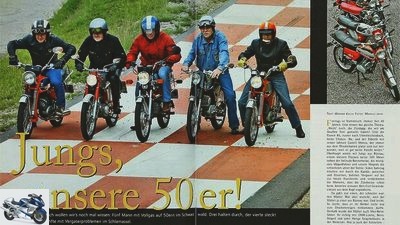
mps photo studio
Issue 6/2005. In focus: 50s mopeds from the 70s.
You’d have to be 16 again, and as crazy as it was back then. Werner “Mini” Koch turned back the clock for MOTORRAD Classic, alerted some of the buddies from the past, and rolled the five 50s to the start, which were popular at the time, such as the “terribly fast Zundapp, the Florett RS with an illegal racing kit on it , a Hercules with rocking full swing chassis, the whistling Maico with rotary valve and the beautiful Honda SS 50, a four-stroke with a fat sound, but with significantly less power ”. Once again the warhorses plunge into the fray, turn the little motors, switch every second, take every slipstream with them and marvel at the unusual handiness of the shot glass hit. The fact that the four-stroke Honda could not match the performance of the then superior German two-stroke engines does not matter in view of their other qualities. Or is it? The old days come back quickly in the minds, including the adolescent, always full throttle driving style. Also including a ride into the botany. But at the end of the day after a pleasurable and insightful trip, everyone agrees: There is no better fountain of youth.
Friedel his machine
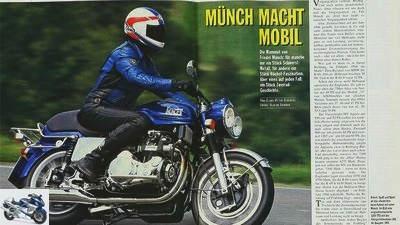
mps photo studio
Issue 1/1997. In focus: Friedel Munch’s mammoth.
A car engine in a motorcycle frame – in view of the V8-equipped Boss Hoss monsters, the idea is no longer spectacular today. In the mid-1960s it was very much when Friedel Munch considered using a four-cylinder from the NSU Prinz for his dream bike, which was to be produced in small series. And from the best of parts, costs shouldn’t play a role. What did not exist was simply made by us. In 1966 the first machine could be admired, after various changes it stood at the IFMA and marked the sensation of the fair. For issue 1/1997, the author Elberth reviews the entire history of Munch and explains what made Friedel Munch tick and how the owner of the photo motorcycle got his bike. The whole madness of the project and the obsession of the resourceful builder, who was ultimately overtaken by technical progress and failed economically, shimmers through here – looking behind the scenes of the Munch myth, so to speak. This makes it easier to understand, but no less fascinating.
Restoring takes time.
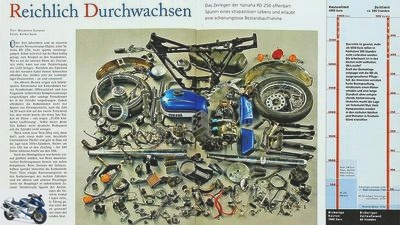
mps photo studio
Issue 3/2007. In focus: the subject of restoration.
If a story spans a good year and eight issues, then it is most likely about restoration. So the (un) luck took its course on a winter day when the editor-in-chief rummaged through ebay and ultimately blindly bought an RD 250 for 644 euros. A bargain?
Only a visit to the home workshop revealed the exact condition. And there should be a lot to do. The budget was set at 4,000 euros, which in the end was significantly blown up with total costs of 7,514 euros. 239 hours of work went into the restoration, a lot could be overhauled, some had to be newly procured. Since then, not only has the color (green instead of blue) been new, but also the displacement: thanks to the assembly of 350 cylinders, the RD has since enjoyed a larger volume and more ample performance. Result of the elaborate campaign: expensive but great.
Reach for the stars
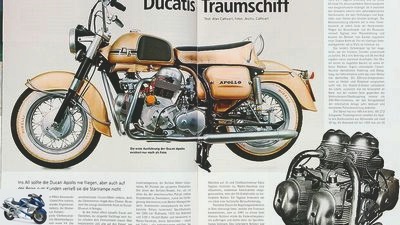
mps photo studio
Issue 4/2009. In focus: Ducati Apollo.
Created in the early 1960s Ducati a powerful street motorcycle with a V4 engine. Only two prototypes were ever built, tire problems stopped the project. MOTORRAD Classic had the great honor of being able to drive the only surviving copy (from the factory museum), the findings can be read in issue 4/2009. The Ducati engine sounds loud and very different from a Honda V4, more like an Ami V8.
With 1256 cm³ it offers a decent displacement, with 100 HP enough power for sovereign cruising. The relaxed sitting posture invites you to do this, and the transmission warns you to be careful when changing gear. Overstrained brakes and the unsuitable 16-inch tires from Goodyear had already shown problems during test drives, so it is better to avoid high speeds and large lean angles. The classic author is impressed and saddened at the same time after the extraordinary journey. His conclusion: “The Apollo is one of the great missed opportunities in motorcycle history – what a shame!”.
Related articles
-
What moved the MOTORRAD editorial team in 111 years
archive Sports & scene What moved the MOTORRAD editorial team in 111 years What moved the MOTORRAD editorial team in 111 years You know what …? There…
-
100 years of MOTORRAD: Epochal bikes
MOTORCYCLE archive motorcycles 100 years of MOTORRAD: Epochal bikes 100 years of MOTORRAD: Epochal bikes signpost On the way to becoming a myth, it is…
-
archive 22nd pictures archive 1/22 … many Kreidler RS wore expressive golf green. archive 2/22 … One of his first candidates in 1935 was a 600 BSA….
-
MOTORRAD Classic Boxer Ride 2015
Bilski 13th pictures Bilski 1/13 Two-valve gravel tour over the Swabian Alb. Bilski 2/13 Nice round after a nice ride on fantastic routes. Bilski 3/13…
-
Scene: Review: 26 years of Buell – Erik Buell remembers
Cathcart 55 pictures Buell 1/55 Erik Buell and the Rotax team at the Rotax plant. Buell 2/55 2003 – Stuntman Craig Jones on an XB9S. Buell 3/55 The Buell…
-
Scene: MOTORRAD CLASSIC spring ride 2011
fact to travel Scene: MOTORRAD CLASSIC spring ride 2011 Scene: MOTORRAD CLASSIC spring ride 2011 Between the Swabian Alb and Lake Constance Content of…
-
MOTORRAD Best Brand 2021: Your favorite brands
manufacturer 24 pictures manufacturer 1/24 The award for technical innovations is not given by readers’ votes, but by the MOTORRAD editorial team. BMW…
-
MOTORRAD drives 125cc classic racers
motorcycles MOTORRAD drives 125cc classic racers MOTORRAD drives 125cc classic racers Dream job 30 years ago he was allowed to sit on it as a young…
-
Best purchase back protectors (MOTORRAD 4-2013)
mps photo studio clothing Best purchase back protectors (MOTORRAD 4/2013) Best purchase back protectors (MOTORRAD 4/2013) Safemax Aero Thorsten Dentges…
-
Best purchase all-weather textile combination test (MOTORRAD 7-2014)
mps studio clothing Best purchase all-weather textile combination test (MOTORRAD 7/2014) Best purchase all-weather textile combination test (MOTORRAD…